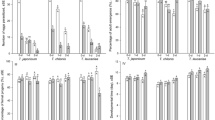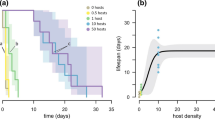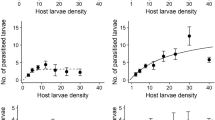Abstract
The effect of host density on parasitism byTrichogramma pretiosum Riley was studied by exposing groups of 150, 300, 600 or 1200 eggs of potato tuber moth to 2, 4 or 8 female parasites per group. The parasite exhibited a type 2 functional response. As host density increasedT. pretiosum parasitised more hosts, but at a decreasing rate. The attack coefficient (a′) decreased as parasite density increased, whereas the handling time (T h ) remained almost constant. The search rate (a) decreased with increasing host density.T. pretiosum responded to increasing host density by increasing the number of its encounters with hosts and the number of hosts it parasitised only up to host density of 300 when the parasite density was 2 and up to host density of 600 when the parasite densities were greater and then remained almost constant. The observed incidence of parasitism was higher than that expected on the assumption that the parasites behaved the same at higher host densities as at the lowest. When parasite density was raised from 2 to 8 females per group the percentage of female progeny fell from about 73 to about 48%. A 2-fold increase in the number of female progeny was observed when parasite density was reduced from 8 to 2 and also when the host density was raised from 150 to 1200 eggs.
Résumé
L'influence de la densité en hôtes sur le parasitisme deTrichogramma pretiosum Riley a été étudiée en soumettant des groupes de 150, 300, 600 et 1200 œufs de la teigne de la pomme de terre à 2,4 ou 8 femelles du parasite pour chaque groupe. Ce parasite manifeste une réponse fonctionnelle de type 2. Lorsque la densité en hôtes augmente,T. pretiosum parasite davantage d'insectes mais avec un taux moindre. Le coefficient d'attaque (a′) diminue quand la densité en parasites s'accroît, tandis, que la durée du parasitisme (T h ) reste à peu près constante: le taux de recherche de l'hôte (a) décroît avec l'accroissement de la densité en hôtes.T. pretiosum répond à une augmentation de celle-ci par un plus grand nombre de rencontres avec l'hôte et d'hôtes parasités, seulement jusqu'à une densité de 300 hôtes quand la densité en parasites est de 2, et jusqu'à 600 hôtes, en restant constants, quand les densités en parasites sont plus élevées.
L'incidence du parasitisme observée est plus importante que celle prévue en supposant que les parasites ont le même comportement pour des densités fortes en hôtes et pour les plus faibles. Quand la densité en parasites passe de 2 à 8 femelles par groupe le pourcentage de femelles dans la descendance tombe de 73% à 48%, Une augmentation de 2 fois du nombre de descendants femelles est notée quand la densité en parasites est réduite de 8 à 2 et aussi lorsque la densité en hôtes passe de 150 à 1 200 œufs.
Similar content being viewed by others
References
Benson, J.F. — 1973. Intraspecific competition in the population dynamics ofBracon hebetor Say [Hym.: Braconidae]. —J. Anim. Ecol., 42, 105–124.
Hassell, M.P. — 1966. Evaluation of parasite or predator responses. —J. Anim. Ecol., 35, 65–75.
Hassell, M.P. — 1978. The Dynamics of Arthropod Predator-Prey Systems. —Princeton Univ. Press, Princeton, 237 pp.
Holling, C.S. — 1959. The components of predation as revealed by a study of small mammal predation of the European pine sawfly. —Can. Entomol., 91, 293–320.
Holling, C.S. — 1961. Principles of insect predation. —Annu. Rev. Entomol., 6, 163–182.
Holling, C.S. — 1966. The functional response of invertebrate predators to prey density. —Mem. Entomol. Soc. Can., 48, 1–86.
Kfir, R. — 1981. Effect of hosts and parasite density on the egg parasiteTrichogramma pretiosium [Hym.: Trichogrammatidae]. —Entomophaga, 26, 455–461.
Kfir, R. — 1982. Reproduction characteristics ofTrichogramma brasiliensis andT. lutea, parasitising eggs ofHeliothis armiger. —Entomol. Exp. Appl., 32, 249–255.
Oatman, E.R. &Platner, G.R. — 1971. Biological control of the tomato fruitworm, cabbage looper, and hornworms on processing tomatoes in southern California, using mass releases ofTrichogramma pretiosum. —J. Econ. Entomol., 64, 501–506.
Oatman, E.R. &Platner, G.R. — 1978. Effect of mass releases ofTrichogramma pretiosum against lepidopterous pests on processing tomatoes in southern California, with notes on host egg population trends. —J. Econ. Entomol., 71, 896–900.
Rogers, D.J. — 1972. Random search and insect population models. —J. Anim. Ecol., 41, 369–383.
Royama, T. — 1971. A comparative study of models for predation and parasitism. —Res. Popul. Ecol., suppl. 1, 1–91.
Stinner, R.E., Ridgeway, R.L., Coppedge, J.R., Morrison, R.K. &Dikerson, W.A. Jr. — 1974. Parasitism ofHeliothis eggs after field releases ofTrichogramma pretiosum in cotton. —Environ. Entomol., 3, 497–500.
Van Lenteren, J.C. — 1976. The development of host discrimination and the prevention of superparasitism in the parasitePseudeucoila bochei Weld [Hym.: Cynipidae]. —Neth. J. Zool., 26, 1–91.
Author information
Authors and Affiliations
Rights and permissions
About this article
Cite this article
Kfir, R. Functional response to host density by the egg parasiteTrichogramma pretiosum . Entomophaga 28, 345–353 (1983). https://doi.org/10.1007/BF02372187
Issue Date:
DOI: https://doi.org/10.1007/BF02372187




